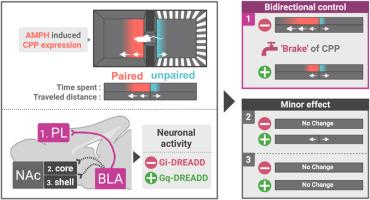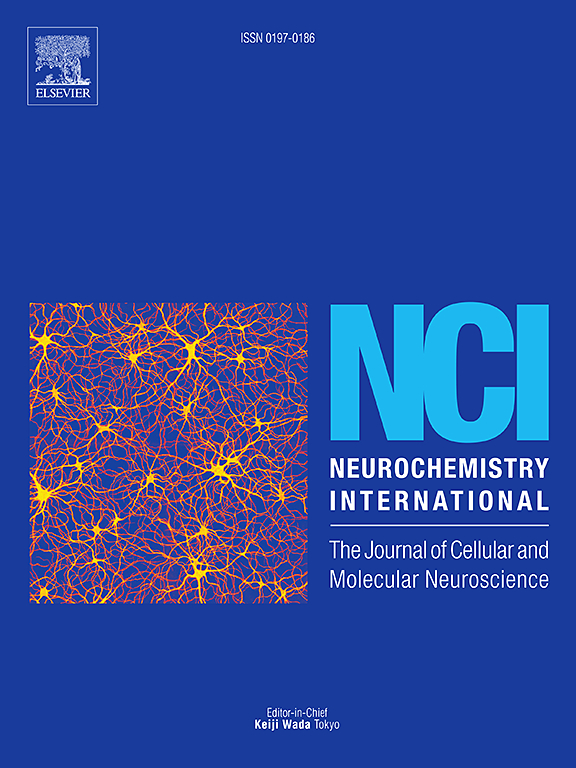安非他明诱导的条件位置偏好的通路特异性调控:杏仁核基底外侧向前边缘皮层和伏隔核亚区投射的化学发生调节
IF 4
3区 医学
Q2 BIOCHEMISTRY & MOLECULAR BIOLOGY
引用次数: 0
摘要
有物质使用障碍的个体会发展出适应性不良的联想记忆,将环境背景与药物体验联系起来。基底外侧杏仁核(BLA)、前边缘皮层(PrL)和伏隔核(NAc)是这些关联背后的神经回路的核心组成部分。然而,目前尚不清楚具体的BLA输出如何不同地调节情境药物记忆的表达。利用特异性药物激活的特异性受体,我们选择性地以去氯氯氮平作为激活剂,调节了苯丙胺诱导的条件位置偏好(CPP)在通往PrL、NAc核心和NAc外壳的BLA通路中的表达过程。我们的研究结果揭示了这些途径之间的分离:BLA-to-PrL回路对CPP表达进行双向控制,抑制显著增强,激活减弱药物环境相关性。相比之下,BLA-to-NAc核心操作选择性地调节了条件反应的运动方面,而不影响位置偏好,而BLA-to-NAc壳操作对CPP表达没有显著影响。这些结果表明,BLA在情境药物记忆的表达中具有独特的通路特异性作用。本文章由计算机程序翻译,如有差异,请以英文原文为准。

Pathway-specific regulation of amphetamine-induced conditioned place preference by chemogenetic modulation of basolateral amygdala projections to prelimbic cortex and nucleus accumbens subregions
Individuals with substance use disorders develop maladaptive associative memories, linking environmental contexts with drug experiences. The basolateral amygdala (BLA), prelimbic cortex (PrL), and nucleus accumbens (NAc) are central components of the neural circuitry underlying these associations. However, it remains unclear how specific BLA outputs differentially regulate the expression of contextual drug memories. Using designer receptors exclusively activated by designer drugs, we selectively modulated neuronal activity with deschloroclozapine as the activating agent during the expression of amphetamine-induced conditioned place preference (CPP) in the BLA pathways to the PrL, NAc core, and NAc shell. Our findings revealed a dissociation between these pathways: the BLA-to-PrL circuit exerted bidirectional control over CPP expression, with inhibition significantly enhancing and activation attenuating drug-context associations. In contrast, BLA-to-NAc core manipulations selectively modulated locomotor aspects of conditioned responses without affecting place preference, while BLA-to-NAc shell manipulations produced no significant effects on CPP expression. These results demonstrate that the BLA has a distinctive pathway-specific roles in the expression of contextual drug memory.
求助全文
通过发布文献求助,成功后即可免费获取论文全文。
去求助
来源期刊

Neurochemistry international
医学-神经科学
CiteScore
8.40
自引率
2.40%
发文量
128
审稿时长
37 days
期刊介绍:
Neurochemistry International is devoted to the rapid publication of outstanding original articles and timely reviews in neurochemistry. Manuscripts on a broad range of topics will be considered, including molecular and cellular neurochemistry, neuropharmacology and genetic aspects of CNS function, neuroimmunology, metabolism as well as the neurochemistry of neurological and psychiatric disorders of the CNS.
 求助内容:
求助内容: 应助结果提醒方式:
应助结果提醒方式:


